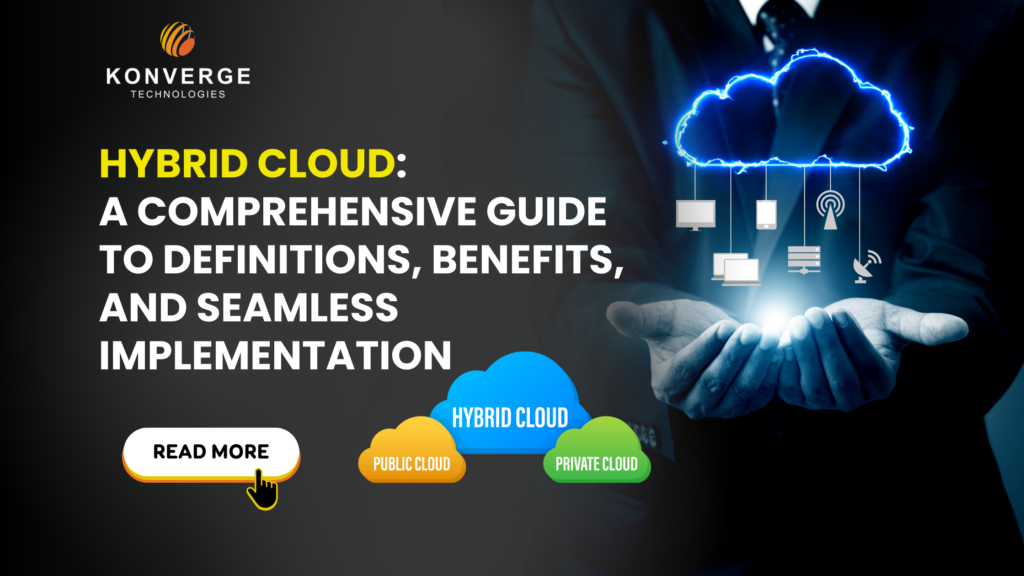Introduction:
In the ever-evolving landscape of cloud computing, businesses are increasingly turning to hybrid cloud solutions to meet their diverse and dynamic IT needs. Understanding the hybrid cloud definition is crucial for organizations aiming to leverage the advantages of both public and private cloud infrastructures seamlessly. In this blog, we delve into the hybrid cloud definition, exploring its core characteristics and highlighting the benefits it brings to businesses.
Hybrid Cloud Definition:
A hybrid cloud refers to a computing environment that combines on-premises infrastructure, private cloud services, and public cloud services. This unique model allows organizations to enjoy the flexibility and scalability of the public cloud while maintaining control over sensitive data through the private cloud. In simpler terms, the hybrid cloud acts as a bridge, enabling data and applications to be shared seamlessly between on-premises and cloud environments.
Key Characteristics of Hybrid Cloud:
Integration of Public and Private Clouds:
A hybrid cloud integrates public cloud services (such as AWS, Azure, or Google Cloud) with a private cloud or on-premises infrastructure.
This integration facilitates data and application portability, allowing businesses to optimize their workloads based on specific requirements.
Orchestration and Management:
Hybrid cloud management involves orchestrating and managing workloads across different environments efficiently.
Advanced orchestration tools ensure seamless communication and workload distribution, optimizing performance and resource utilization.
Security and Compliance:
Private clouds offer enhanced security for sensitive data, making them ideal for compliance with regulatory requirements.
Businesses can strategically choose where to store and process data, aligning with security and compliance standards specific to their industry.
How Do Hybrid Clouds Work?
The integration of these environments is facilitated by a hybrid cloud management layer, which acts as the orchestrator for workloads. Here’s a breakdown of the process:
Workload Distribution:
Hybrid cloud management identifies the nature of workloads and strategically allocates them to the most suitable environment, considering factors like security, scalability, and cost.
Data and Application Portability:
The hybrid cloud allows for seamless movement of data and applications between on-premises, private, and public cloud environments, ensuring flexibility and optimization.
Security Measures:
Security protocols are customized based on the sensitivity of the data and applications. Sensitive information can be kept in private clouds, while non-sensitive workloads utilize the cost-effective resources of public clouds.
Scalability and Resource Optimization:
Hybrid cloud architecture enables businesses to scale dynamically by utilizing the infinite resources of public clouds during peak periods and optimizing costs by leveraging private clouds for critical applications.
Understanding how hybrid clouds work is essential for businesses seeking a balanced and efficient IT solution. Let’s delve into the intricacies of hybrid cloud architecture, exploring the types of environments found in hybrid clouds along with their advantages and disadvantages.
Understanding Hybrid Cloud Architecture:
Let’s delve into the different environments within hybrid cloud architecture, exploring their intricacies along with their advantages and disadvantages.
1. On-Premises (Private Cloud):
Overview:
On-premises infrastructure refers to the traditional computing environment where the organization owns and maintains its own physical servers and data centers. This is essentially a private cloud setup dedicated exclusively to the organization.
Advantages:
Direct Control: Organizations have full control over their hardware, data, and applications.
Enhanced Security: Sensitive information can be kept within the organization’s boundaries, ensuring a higher level of security.
Disadvantages:
Limited Scalability: Scaling on-premises infrastructure can be slower and more expensive than utilizing the resources of public cloud providers.
Higher Upfront Costs: Establishing and maintaining on-premises infrastructure requires substantial upfront capital investment.
2. Private Cloud:
Overview:
A private cloud involves cloud computing resources dedicated exclusively to one organization. It can be hosted on-premises or by a third-party provider.
Advantages:
Scalability and Flexibility: Private clouds offer scalability, allowing organizations to adjust resources based on workload demands.
Customized Security Measures: Organizations can implement tailored security protocols to meet specific compliance requirements.
Disadvantages:
Infrastructure Maintenance: While private clouds offer flexibility, they still require ongoing maintenance, which can be resource-intensive.
Scalability Limitations: Private clouds may not match the infinite scalability of public clouds.
3. Public Cloud:
Overview:
Public clouds are provided by third-party service providers and offer computing resources on a pay-as-you-go basis. Examples include AWS, Azure, and Google Cloud.
Advantages:
Infinite Scalability: Public clouds provide virtually limitless resources, making them ideal for handling variable workloads and scaling as needed.
Cost-Effective for Non-Sensitive Workloads: Public clouds are cost-effective for non-sensitive applications, as organizations only pay for the resources they consume.
Disadvantages:
Security Concerns: Concerns may arise regarding the security of sensitive data stored in public clouds, although providers implement robust security measures.
Dependency on External Service Providers: Organizations rely on external providers, which could result in potential service disruptions if the provider faces issues.
4. Hybrid Cloud Management Layer:
Overview:
The hybrid cloud management layer acts as the glue that ties together on-premises infrastructure, private clouds, and public clouds. It facilitates seamless communication, workload distribution, and resource optimization.
Advantages:
Efficient Workload Orchestration: The management layer orchestrates workloads, ensuring they run in the most suitable environment based on factors like security, compliance, and performance.
Optimized Resource Allocation: Allows for the efficient allocation of resources, balancing the benefits of private and public clouds.
Disadvantages:
Specialized Skill Requirement: Managing a hybrid cloud environment requires specialized skills, potentially necessitating additional training for IT staff.
Integration Complexity: Integrating diverse cloud environments can be complex and may require sophisticated tools and middleware.
Types of Environments Found in Hybrid Clouds:
Development and Testing Environment in Hybrid Clouds:
Development and testing environments in hybrid clouds provide a dynamic platform for software development and testing processes. This setup allows developers to scale resources cost-effectively during various stages of application development.
Advantages:
Cost-effective Scalability: Hybrid clouds enable developers to scale resources up or down as needed during different development phases. This flexibility ensures that the required computing power and storage are available, optimizing costs.
Disadvantages:
Security Concerns: The development and testing environment may involve proprietary code and sensitive data. Security concerns arise regarding the protection of intellectual property and ensuring data privacy, especially when using a hybrid infrastructure.
Production Environment in Hybrid Clouds:
The production environment in hybrid clouds is designed for hosting critical applications and managing sensitive data securely. This environment prioritizes stability and reliability to ensure uninterrupted service for end-users.
Advantages:
Enhanced Security: Hybrid cloud solutions offer robust security measures, making them suitable for hosting critical applications. Advanced security features protect sensitive data, reducing the risk of unauthorized access and potential breaches.
Disadvantages:
Potential Higher Costs: Hosting resource-intensive applications in a hybrid cloud’s production environment may lead to increased costs. Balancing performance requirements with cost considerations becomes crucial, as some applications may demand higher resource allocations.
Backup and Disaster Recovery Environment in Hybrid Clouds:
The backup and disaster recovery environment in hybrid clouds focuses on safeguarding data by providing geographical redundancy. This setup ensures data protection and facilitates swift recovery in case of unforeseen events.
Advantages:
Geographical Redundancy: Hybrid clouds offer the advantage of redundant storage across different geographic locations. This ensures data availability even if one location experiences a failure, enhancing overall disaster recovery capabilities.
Disadvantages:
Latency Concerns: Careful planning is required to avoid latency issues when implementing backup and disaster recovery solutions. Geographical dispersion can introduce delays in data access and retrieval, impacting the efficiency of recovery processes. thorough planning and optimization are necessary to mitigate latency challenges.
Benefits of Hybrid Cloud:
Scalability and Flexibility:
Hybrid cloud solutions offer unparalleled scalability, allowing businesses to scale their operations seamlessly as demands fluctuate.
The flexibility to choose the most suitable environment for each workload enhances resource efficiency and cost-effectiveness.
Enhanced Security and Compliance:
Sensitive data can be stored in a private cloud, ensuring enhanced security and compliance with industry regulations.
The ability to customize security measures based on specific needs provides an added layer of protection.
Cost Optimization:
A hybrid cloud enables businesses to balance costs effectively by utilizing public cloud resources for non-sensitive workloads and leveraging the cost-effectiveness of private clouds for critical applications.
Disaster Recovery and Business Continuity:
With data distributed across multiple environments, hybrid cloud architecture enhances disaster recovery capabilities.
In the event of a system failure or data loss, businesses can quickly recover and maintain continuous operations.
Implementing Hybrid Cloud Services:
Implementing a hybrid cloud strategy involves careful planning and execution. Here are key steps to effectively deploy and manage hybrid cloud services:
Assessment and Planning:
Conduct a thorough assessment of your existing IT infrastructure, identifying workloads suitable for the cloud and those that need to remain on-premises.
Develop a comprehensive plan outlining the integration of public and private cloud resources based on your organization’s specific requirements.
Choosing the Right Providers:
Select reputable public cloud service providers that align with your business goals and offer the services required for your workloads.
Evaluate private cloud solutions that provide the security and customization necessary for your sensitive data and critical applications.
Integration Tools and Middleware:
Invest in integration tools and middleware to ensure seamless communication and data transfer between different cloud environments.
Automation and orchestration tools play a crucial role in managing workloads efficiently and optimizing performance.
Security Measures:
Implement robust security measures across all cloud environments, including encryption, identity management, and access controls.
Regularly update and audit security protocols to address emerging threats and maintain compliance with industry regulations.
Monitoring and Optimization:
Utilize monitoring tools to keep track of performance, resource utilization, and potential issues across the hybrid cloud infrastructure.
Continuously optimize workloads by adjusting resource allocation and leveraging automation for scaling based on demand.
Employee Training and Adoption:
Provide training programs to ensure that your IT staff is well-equipped to manage and troubleshoot issues within a hybrid cloud environment.
Foster a culture of adaptation and continuous learning to keep pace with evolving cloud technologies.
Challenges and Considerations:
While the benefits of hybrid cloud are substantial, businesses should be mindful of potential challenges:
Complexity:
Managing a hybrid cloud environment can be complex, requiring specialized skills and tools.
Organizations must invest in training and resources to navigate this complexity effectively.
Data Transfer and Latency:
Consider the impact of data transfer and latency when distributing workloads between on-premises and cloud environments.
Optimize network connectivity and choose data storage locations strategically to minimize delays.
Cost Management:
Carefully monitor and manage costs associated with hybrid cloud services.
Implement cost-tracking tools and regularly review resource allocation to avoid unexpected expenses.
Regulatory Compliance:
Ensure compliance with data protection and privacy regulations, especially when dealing with sensitive information across different cloud environments.
Stay informed about changes in regulations and adapt your hybrid cloud strategy accordingly.
Looking Ahead: Future Trends in Hybrid Cloud Management
As technology continues to evolve, the landscape of hybrid cloud management is set to witness several trends:
Edge Computing Integration:
The integration of edge computing with hybrid cloud solutions will become more prevalent, enabling real-time processing and analysis of data at the edge of the network.
AI and Automation:
The use of artificial intelligence (AI) and automation tools will increase to optimize workload distribution, enhance security measures, and streamline management processes.
Multi-Cloud Strategies:
Businesses will increasingly adopt multi-cloud strategies, leveraging the strengths of different cloud providers to avoid vendor lock-in and enhance redundancy.
Containerization and Microservices:
Containerization and microservices architecture will play a crucial role in the deployment and management of applications within hybrid cloud environments, promoting agility and scalability.
How Konverge Technologies Can Help
As businesses navigate the complex landscape of hybrid cloud implementation, partnering with a reliable and experienced provider becomes paramount. Konverge Technologies stands out as a leading expert in hybrid cloud solutions, offering tailored services to address the unique needs of your organization.
Why Choose Konverge Technologies for Hybrid Cloud Solutions:
Expertise in Hybrid Cloud Management:
Konverge Technologies boasts a team of seasoned professionals with expertise in managing hybrid cloud environments. Our specialists understand the intricacies of integrating on-premises infrastructure, private clouds, and public clouds, ensuring a seamless and efficient orchestration of workloads.
Proven Track Record:
With a proven track record of successful hybrid cloud implementations, Konverge Technologies has helped numerous businesses achieve optimal performance, enhanced security, and cost-effectiveness. Our case studies and client testimonials speak volumes about our commitment to delivering tangible results.
Tailored Solutions for Your Business:
We recognize that each organization has unique requirements. Konverge Technologies takes a personalized approach to hybrid cloud solutions, working closely with you to understand your business goals, compliance needs, and scalability requirements. Our solutions are crafted to align perfectly with your objectives.
Cutting-Edge Technologies:
Staying at the forefront of technological advancements, Konverge Technologies integrates cutting-edge tools and practices into our hybrid cloud solutions. This ensures that your business benefits from the latest innovations in cloud computing, AI, automation, and security.
Comprehensive Training and Support:
Understanding that the successful implementation of hybrid cloud solutions extends beyond the initial setup, Konverge Technologies provides comprehensive training for your IT staff. Our ongoing support ensures that your team is equipped to manage and optimize the hybrid cloud environment effectively.
Cost-Efficiency and Value:
Konverge Technologies is committed to delivering cost-effective solutions without compromising on quality. We believe in providing tangible value to our clients by optimizing resource allocation, managing costs, and delivering a robust hybrid cloud infrastructure that aligns with your budgetary constraints.
Strategic Planning and Scalability:
Our team works collaboratively with your organization to develop a strategic plan for hybrid cloud implementation. Whether you are looking to scale dynamically, enhance security measures, or optimize costs, Konverge Technologies has the expertise to guide you towards achieving your goals.
In conclusion, choosing Konverge Technologies for your hybrid cloud implementation is a strategic decision that ensures a smooth and successful transition to a robust IT infrastructure. With our expertise, proven track record, and commitment to client success, we are confident in our ability to empower your organization with the advantages of hybrid cloud solutions. Contact Konverge Technologies today to embark on a journey toward an optimized, secure, and scalable hybrid cloud environment.





